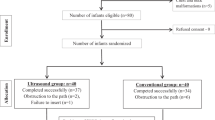Abstract
Background
Peripherally inserted central catheters (PICCs) represent a mainstay of intravascular access in the neonatal intensive care setting when long-term vascular access is needed. Ideally, PICCs should be inserted and maintained in a central position with the tip ending in the superior or inferior vena cava. This is not always achievable, and sometimes the tip remains in a peripheral location. Higher complication rates have been reported with non-central PICCs; however these findings have not been confirmed in a solely neonatal series and PICCs with tips in peripheral veins have not been studied.
Objective
To compare complication rates and length of catheter duration related to PICC position in neonates.
Materials and methods
We conducted a retrospective analysis of all PICCs inserted in term and preterm infants in a tertiary neonatal intensive care unit between May 2007 and December 2009. A single pediatric radiologist reinterpreted the catheter tip site on initial anteroposterior (AP) chest radiographs and categorized sites as central (superior vena cava, inferior vena cava, brachiocephalic vein), intermediate (subclavian, axillary, common or external iliac veins), or peripheral (veins peripheral to axillary or external iliac veins). We analyzed complication rates and length of catheter duration among the three categories.
Results
We collected data on a total of 176 PICCs. Infants with PICCs in a central location had a significantly lower complication rate (18/97, 19%) than those with the PICC tip in an intermediate (24/64, 38%) or peripheral (9/15, 60%) locations (P=0.0003). Length of catheter duration was noted to be longest with central, intermediate with intermediate, and shortest with peripheral PICC tip locations (17.7±14.8 days for central vs. 11.4±10.7 days for intermediate vs. 5.4±2.5 days for peripheral, P=0.0003).
Conclusion
A central location is ideal for the tip of a PICC. When this is not achievable, an intermediate location is preferable to a more peripheral position.


Similar content being viewed by others
References
Racadio J, Doellman D, Johnson N et al (2001) Pediatric peripherally inserted central catheters: complication rates related to catheter tip location. Pediatrics 107:e28
Jumani K, Advani S, Reich NG et al (2013) Risk factors for peripherally inserted central venous catheter complications in children. JAMA Pediatr 167:429–435
Jain A, Deshpande P, Shah P (2013) Peripherally inserted central catheter tip position and risk of associated complications in neonates. J Perinatol 33:307–312
Orme RMLE, McSwiney MM, Chamberlain-Weber RFO (2007) Fatal cardiac tamponade as a result of a peripherally inserted central venous catheter: a case report and review of the literature. Brit J Anaesth 99:384–388
Hogan MJ (1999) Neonatal vascular catheters and their complications. Radiol Clin N Am 37:1109–1125
Sharp R, Esterman A, McCutcheon H et al (2014) The safety and efficacy of midlines compared to peripherally inserted central catheters for adult cystic fibrosis patients: a retrospective, observational study. Int J Nurs Stud 51:694–702
Bashir RA, Kamala S, Vayalthrikkovil S et al (2016) Association between peripherally inserted central venous catheter insertion site and complication rates in preterm infants. Am J Perinatol 33:945–950
Yang C-Y, Fu R-H, Lien R, Yang P-H (2014) Unusual presentation of renal vein thrombosis in a preterm infant. Urol Case Rep 2:117–119
Kuhle S, Massicotte P, Chan A, Mitchell L (2004) A case series of 72 neonates with renal vein thrombosis. Data from the 1-800-NO-CLOTS Registry. Thromb Haemost 92:729–733
Wrightson DD (2013) Peripherally inserted central catheter complications in neonates with upper versus lower extremity insertion sites. Adv Neonatal Care 13:198–204
Hoang V, Sills J, Chandler M et al (2008) Percutaneously inserted central catheter for total parenteral nutrition in neonates: complications rates related to upper versus lower extremity insertion. Pediatrics 121:e1152–e1159
Author information
Authors and Affiliations
Corresponding author
Ethics declarations
Conflicts of interest None
Rights and permissions
About this article
Cite this article
Goldwasser, B., Baia, C., Kim, M. et al. Non-central peripherally inserted central catheters in neonatal intensive care: complication rates and longevity of catheters relative to tip position. Pediatr Radiol 47, 1676–1681 (2017). https://doi.org/10.1007/s00247-017-3939-1
Received:
Revised:
Accepted:
Published:
Issue Date:
DOI: https://doi.org/10.1007/s00247-017-3939-1




